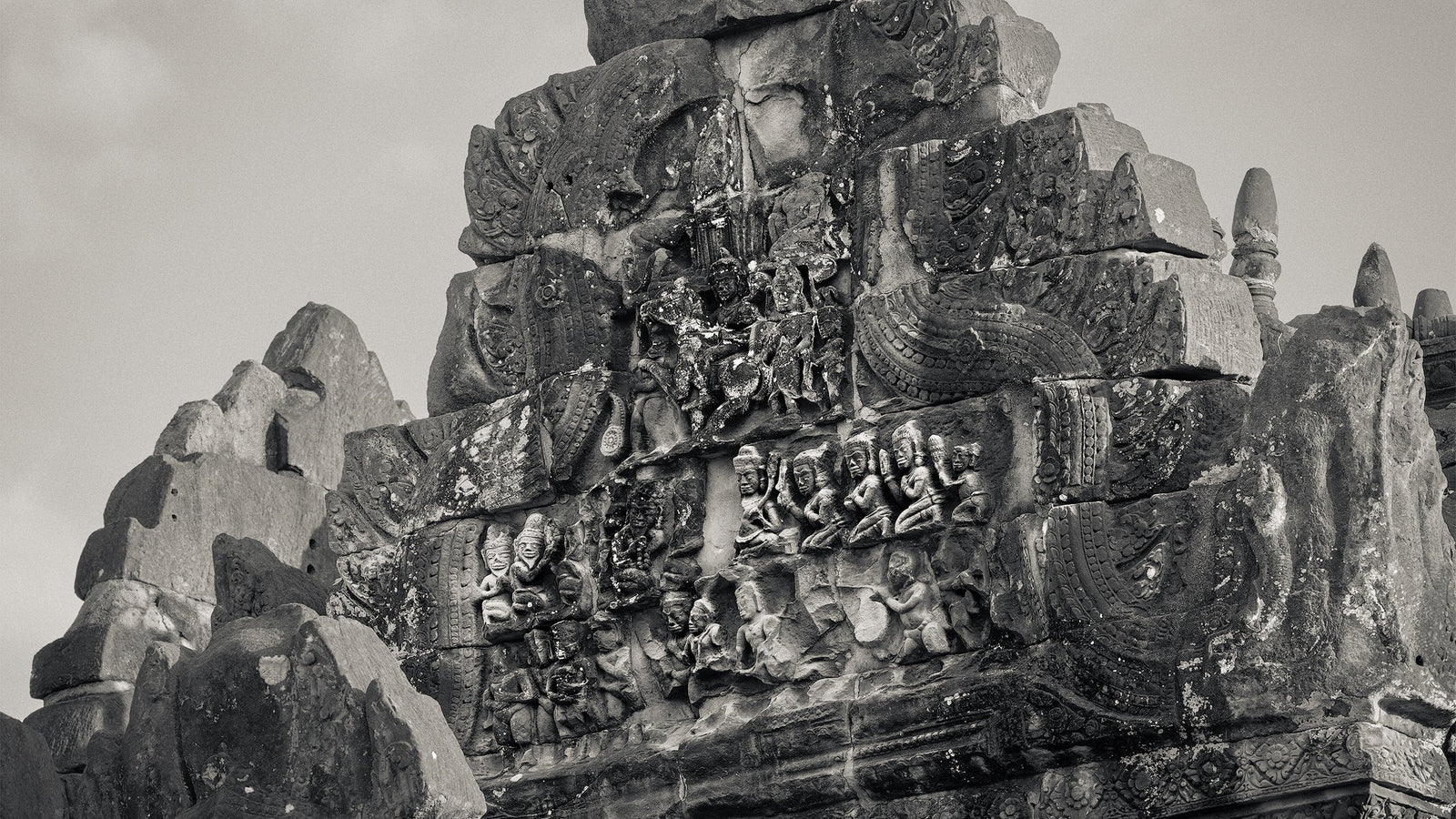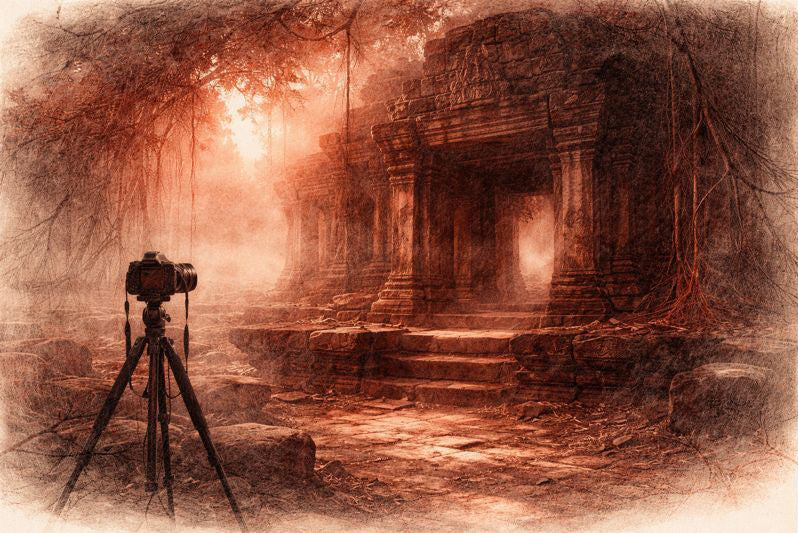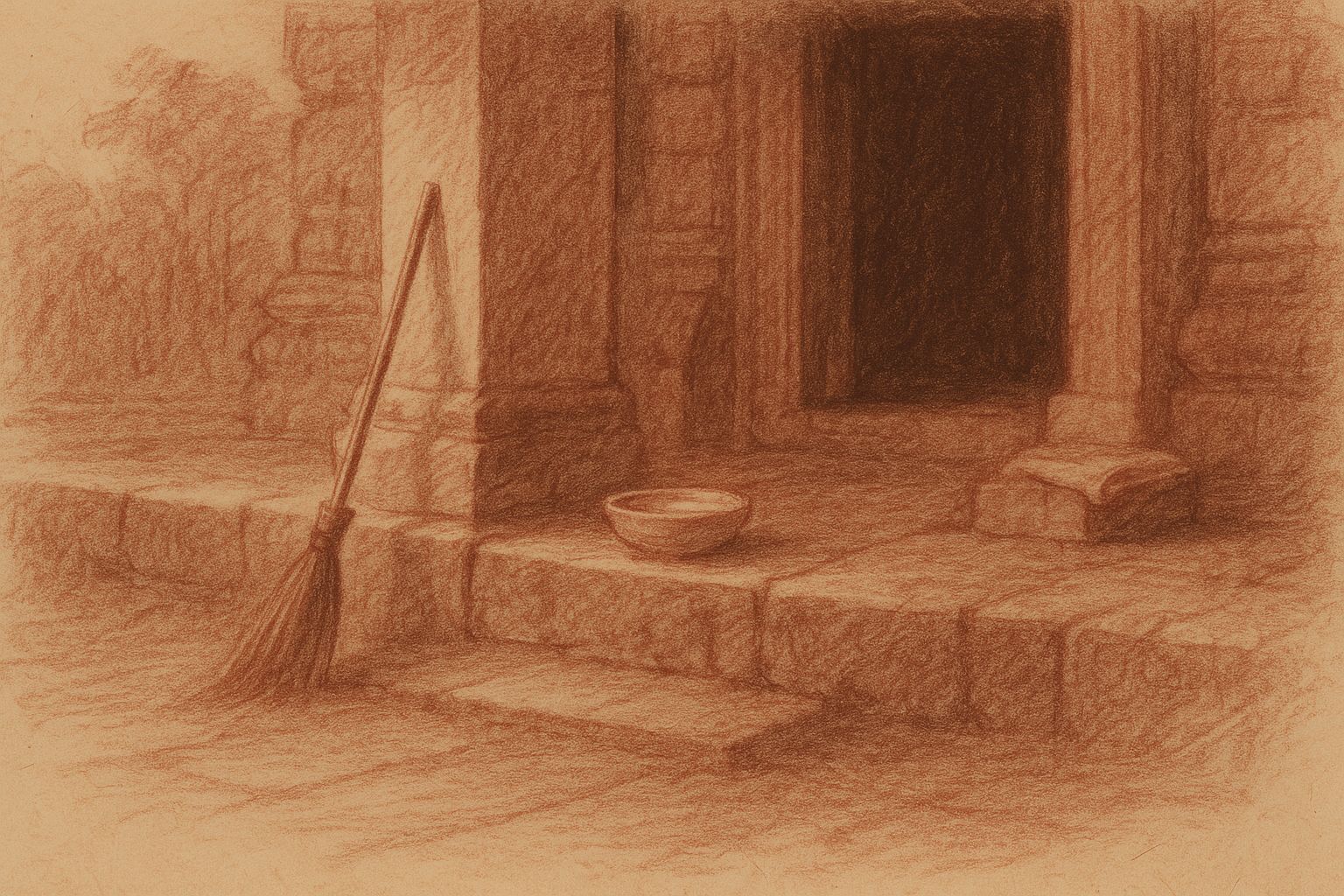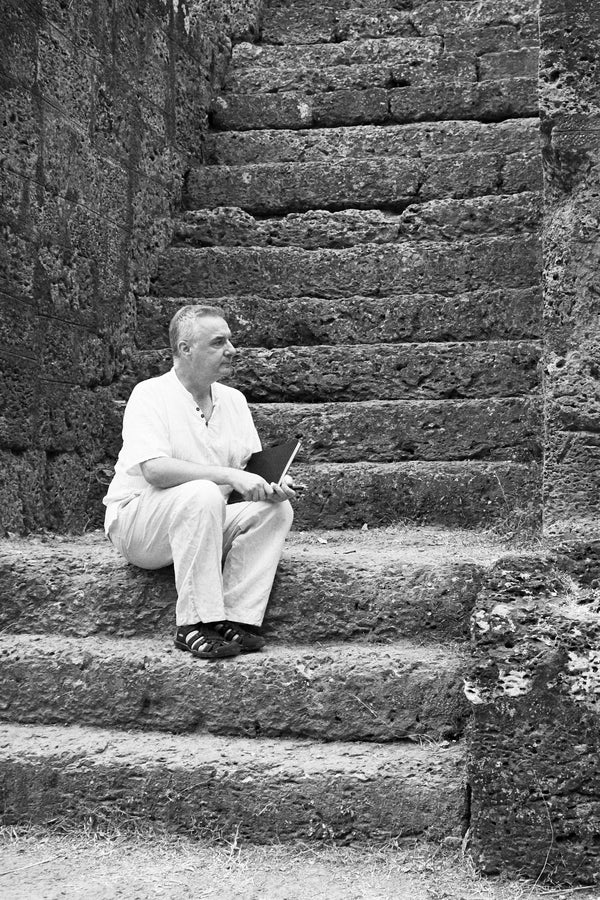Complimentary worldwide shipping on orders over $400 · No import tariffs for most countries
Complimentary worldwide shipping on orders over $400 · No import tariffs for most countries

The Four That Opened the Gate
Sanctuary of Meaning · Journal Article
He saw an old man, and the veil tore.
He saw a corpse, and the world cracked open.
He saw a sage, and remembered the way home.
—from a field note, Ta Prohm Temple
—
This morning, under the hush of banyan limbs and half-lit stone, Annie and I walked the east gopura of Ta Prohm Temple—where vines cradle the ruined medallions like garlands left by time. We had come in search of what remains of the Buddha’s earliest awakenings—those rare and weathered carvings in Angkor that do not crown, but dissolve.
One carving, in particular, stopped us.
It lies just before the newly restored Hall of Dancers, whose delicate stone has been coaxed back into grace by the patient hands of artisans who, through long years of global stillness, were summoned into sacred labour. The restoration was completed in 2023 by the Archaeological Survey of India—a nine-year devotion that wove memory, livelihood, and reverence into stone.
But our gaze passed over the Hall and came to rest on the medallion beyond.
There, as if conjured by shadow and rainlight, we saw what may be the Buddha’s third vision: the confrontation with death. A man lies prone, entrails exposed, while a beast devours what remains. It is raw. Earthbound. Unmistakably mortal. There is no stylised detachment here—only the truth of flesh undone by time.

Buddha’s Encounter with a Corpse, Ta Prohm Temple, Angkor, Cambodia
This large medallion on the eastern gopura of Enclosure II may depict the Buddha’s vision of a corpse. The visceral portrayal—perhaps a beast consuming the body—echoes the unflinching gravity of this pivotal moment in Siddhartha’s awakening.
—
The story behind this moment is older than stone.
In a previous entry, I wrote of Siddhartha’s miraculous birth and the prophecy of the seer Asita—that the boy would one day forsake his kingdom, endure great trials, and shatter the wheel of rebirth. But Asita’s vision was only a whisper. The gods, it seems, would not wait for memory alone to stir him. They would open his eyes with four visions—gentle as thunder, silent as fate.
At sixteen, Siddhartha lived veiled in palace light. His father, King Shuddhodana, fearing the prophecy’s fulfilment, had built a world without shadow: music, perfume, silken pleasures, and dancers’ hands. Even Yashodhara, his radiant bride, was a gift chosen with care. A son, Rahula, soon followed. The lineage was secured. All was as it should be.
Until the prince asked to leave.
—
The first encounter came along a road cleared by royal command. The old were hidden. The sick dispersed. The dead, forbidden. But the gods—who rarely heed human design—conjured an old man with bent spine and trembling limbs. The prince stared in disbelief. “Will I become thus?” he asked. The charioteer nodded. In that moment, the illusion of youth fell away like petals after rain.
The second encounter brought disease. Once again, the gods intervened. Siddhartha saw a man ravaged by sickness. Fragility overwhelmed him. How easily joy frayed. How swiftly the body betrayed. He returned to the palace, but the music no longer held him.
Then came the third.
A corpse. Still. Irrevocable. The prince was transfixed. How could the world carry on—adorning itself, celebrating—when this truth awaited all? That death lay beneath every garland? That every breath leaned toward dissolution?
This vision, perhaps more than any other, broke the thread of the world he had known.
—
And yet the gods had one final image to offer—not despair, but the doorway beyond it.
On the fourth excursion, Siddhartha saw a holy man—serene, detached, radiant not in form but in peace. Here was someone who had turned away, not in fear, but in understanding. The prince’s heart stirred.
And then—by grace, or divine orchestration—he encountered a woman whose presence awakened not desire, but the memory of stillness. The idea of nirvana began to rise within him like light through mist. The seed stirred. The path opened.

Siddhartha Meeting a Holy Man, Banteay Samré Temple, Angkor, Cambodia
This high pediment relief on the northern gopura of Banteay Samré shows the prince on horseback, a lotus in hand, passing a temple or palace. In the lower register, he kneels before forest sages—one holding a rosary. It is a stone hymn to the Fourth Encounter: the moment of inward turning.
—
The sacred implication is not that these encounters taught Siddhartha something new, but that they reawakened what he had always known. The wonder lies not in discovery, but in remembrance.
He saw the impermanence of flesh, the vanishing of beauty, the futility of worldly delight—and realised that the pleasures of the palace were not wrong, only insufficient. They could not shield him from what must come.
And so he withdrew. Not from life, but from illusion. He laid down the crown before it ever touched his brow. He turned not from love, but from forgetting.
The gods had opened the gate. The man would walk through it alone.
—
Four winds of sorrow—
but the fifth was the still one
that led to the path.
There are few depictions of these stories in Khmer stone. But when they appear—in crumbling medallions and softened gopuras—they offer more than narrative. They offer a pulse of awakening, caught mid-beat. The sculptors did not need to complete the tale. A bowed head. A lotus in hand. A rosary resting on stone. These are enough.
The rest unfolds in the one who sees.
—
Even now, beneath the tangled trees of Ta Prohm, the Four Encounters linger like shadows cast by light. They are not only the story of a prince, but of all who wake.
And once seen, they cannot be unseen.
Also in Library

Before the Shutter Falls
3 min read
Before the shutter falls, fear sharpens and doubt measures the cost of waiting. In the quiet hours before dawn, the act of not-yet-beginning becomes a discipline of attention. This essay reflects on patience, restraint, and the quiet mercy that arrives when outcome loosens its hold.

Those Who Keep the Way Open — On the Quiet Guardians of Angkor’s Thresholds
3 min read
Quiet gestures shape the way into Angkor — a swept stone, a refilled bowl, a hand steadying a guardian lion. This essay reflects on the unseen custodians whose daily care keeps the thresholds open, revealing how sacredness endures not through stone alone, but through those who tend its meaning.

Multiplicity and Mercy — The Face Towers of Jayavarman VII
5 min read
A new vision of kingship rises at the Bayon: serene faces turned to every horizon, shaping a world where authority is expressed as care. Moving through the terraces, one enters a field of steady, compassionate presence — a landscape where stone, light, and time teach through quiet attention.
Join My Studio Journal
Receive occasional letters from my studio in Siem Reap—offering a glimpse into my creative process, early access to new fine art prints, field notes from the temples of Angkor, exhibition announcements, and reflections on beauty, impermanence, and the spirit of place.
No noise. No clutter. Just quiet inspiration, delivered gently.
Subscribe and stay connected to the unfolding story.

Join My Studio Journal
Receive occasional letters from my studio in Siem Reap—offering a glimpse into my creative process, early access to new fine art prints, field notes from the temples of Angkor, exhibition announcements, and reflections on beauty, impermanence, and the spirit of place.
No noise. No clutter. Just quiet inspiration, delivered gently.
Subscribe and stay connected to the unfolding story.
